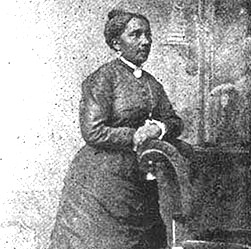

More than a century before Rosa Parks refused to give up her seat on a Montgomery, Ala., bus in 1955, an African-American woman refused to give up her seat on a horse-driven streetcar in New York City.
Elizabeth Jennings refused to relinquish her seat in July 1854. As a result, she was brutally attacked and thrown off the streetcar. She was 24 years old and on her way to church. Streetcars in the 1830s and 1840s were privately owned, and the drivers decided who could ride or not. They carried whips to keep African Americans away.
In a segregated system, African-American travelers were not welcome, and challenging the system was dangerous. By the late 1840s, there were special public buses that African Americans could ride, which were marked with signs on the back or sides reading “Colored Persons Allowed.” However, these buses ran infrequently, irregularly and often not at all.
A New York Tribune February 1855 article about the Jennings incident and subsequent court case reported: “The conductor undertook to get her off, first alleging the car was full, when that was shown to be false. He pretended the other passengers were displeased at her presence. But [when] she insisted on her rights, he took hold of her by force to expel her. She resisted. The conductor got her down on the platform, jammed her bonnet, soiled her dress and injured her person. Quite a crowd gathered. But she effectually resisted. Finally, after the car had gone on further, with the aid of a policeman they succeeded in removing her.” (tinyurl.com/y4ysuhp8)
The African-American community was enraged, and the day after the incident they held a rally at Jennings’ church. Just as Rosa Parks did, Jennings took her case to court. She sued the streetcar company, the driver and the conductor. She was represented by a law firm in which a future president of the U.S., Chester A. Arthur, was a lawyer; the firm was hired because it had demonstrated skill in the area of civil rights the year before.
News of the Jennings’ incident and lawsuit went national. In 1855, a Brooklyn Circuit Court judge ruled in Jennings’ favor: “Colored Persons if sober, well behaved and free from disease, had the same rights as others and could neither be excluded by any rules of the company, nor by force or violence.” She won $225 in damages. As the Tribune reported, “Some jury members had peculiar actions as to colored people’s rights.”
Within a month of the Jennings decision, however, an African-American man was barred from a railway car. He too filed a lawsuit and settled out of court. But streetcar segregation in New York City didn’t end until more than 20 years later, a decade after the Civil War.
Jennings taught in the city’s African-American schools and later in the public school system in the 1850s and 1860s. She married in 1860 and became Elizabeth Graham. In 1895, she founded the first African-American kindergarten.
Her father, Thomas Jennings, owned a tailor shop and was well respected. In 1821, he had been the first Black person to receive a patent for dry-cleaning clothes. He was also a civil rights activist and with others formed the Black Legal Rights Association. Jennings also worked with Frederick Douglass to eliminate slavery in the U.S. Frederick Douglass’ newspaper also reported on Elizabeth Jennings’ incident and case.
After the Civil War began in 1861, a resolution was passed in July 1863 which allowed wealthy New Yorkers to buy their way out of the draft. Angry working-class, mostly Irish immigrants in lower Manhattan were resentful and rioted for four days, targeting mostly African Americans and abolitionists in what became known as the “Draft Riots.” Blacks were exempt from the draft — because they were not considered citizens.
Resentful white immigrants assumed that newly emancipated Blacks in the South would migrate to New York and compete for jobs. The white mobs looted and destroyed homes, and they burned down the Colored Orphanage Asylum. The official death toll was 119 — more than 70 Blacks were lynched, many more beaten or killed. Elizabeth Jennings’ 1-year-old son died during the violence. Jennings herself died in 1901.
African Americans fled uptown to Harlem, Brooklyn and New Jersey, resulting in a 20 percent decline in their population in lower Manhattan. The New York City “Draft Riots” are considered the largest civil uprising in U.S. history.
In 1873 the New York Civil Rights Act was passed, giving legal rights to Blacks on public transportation. A street sign in lower Manhattan on Park Row today carries Elizabeth Jennings’ name.
During Women’s History Month this March, NYC’s First Lady, Chirlane McCray, announced that a monument to Elizabeth Jennings Graham will be constructed and dedicated in Grand Central Station in Manhattan to honor one of the city’s influential women. Monuments will also be constructed and dedicated to three women in other boroughs as part of the “She Built NYC” initiative.
Sources: NY Historical Society, July 2018; baruch.cuny.edu; MSNBC, Jan. 13 and Feb. 25; New York Times, Feb. 13, by Amisha Padnani and Veronica Chambers.
In the 1950s, when Japan and much of Europe was in ruins, the U.S. accounted…
This “Call from the General Federation of Trade Unions in Gaza to Labor Unions in…
Desde que la administración de Donald Trump/Elon Musk tomó las riendas del poder a finales…
Philadelphia Palestine activists marched from Philadelphia City Hall to Day & Zimmermann on April 18…
Marching up Blue Hill Avenue through the Black and immigrant Dorchester neighborhood, Trans Day of…
This statement was recently issued by over 30 groups. On Friday, March 28, Dr. Helyeh…